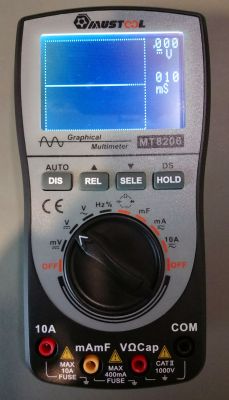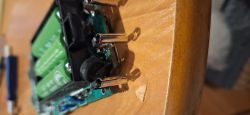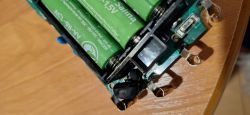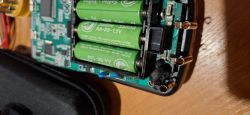Graphical multimeter MUSTOOL MT8206
Taking advantage of the promotion, I bought such a meter on the Banggood.com portal for less than 38 EUR (160 PLN). I will briefly try to describe here why (not) it is worth buying it.
The parcel arrived very quickly (13 days), it was sent by Dutch post from ... the Netherlands. There is no trace that it is a shipment from China, there is no customs declaration, there is only one address sticker and nothing under it ... and what's inside. Well, inside was a cardboard box (colored) with a meter. The meter is quite large, but it does not differ from the average: 160x80x30, it does not have a holster, it is twisted with 4 thin screws. It is quite heavy, weighing 260g with batteries. The structure is quite stiff and makes a positive impression. It is powered by 3 AA (R6) batteries. The set includes a cover and decent quality test leads (very flexible, but not silicone) and a user manual (in English):

The screen is a graphic, monochrome negative LCD, with LED (cool white) backlighting. The font unnecessarily mimics a 7-segment display. The range selector knob is quite small and it moves quite heavy, and at the same time "dull". Occasionally, the meter reboots or turns off completely while switching ranges. The function buttons sometimes lock in the pressed position. While in the lying position the meter can be operated with one hand, in the standing position - it is out of the question. The service itself is quite intuitive to eat, and the first thing that catches the eye is - "he's so slow". The multimeter has a bargraph, but I have the impression that its refresh rate is ... lower than that of the digital display. The meter belongs to the 4000 counts category, which is not the best. It has a relative measurement mode (REF) and the possibility of manual selection of the measuring range. Have I already written that it is terribly slow? He sometimes "misses" the result, but not always. Sometimes the indication slowly increases, sometimes "oL" appears "along the way" (when switching the range), and sometimes "overshoot", eg measurement 12V - subsequent indications: 3.00, 14.06, 12.01. As for the oscilloscope function - it was no surprise here - there is ... and so much good you can write about it (which was to be expected from the description). The oscilloscope works in the equivalent time sampling mode, you need to wait about 2 seconds for the graph to refresh, there are no divisions, only the time base is adjustable. It realistically allows for the imaging of the waveform to a frequency of about 8kHz, but above 5kHz it is difficult to distinguish a triangular wave from a sinusoidal one. Oscilloscope mode is available in the voltmeter and ammeter ranges for both AC and DC ranges. For DC ranges it acts as an oscillograph (slow-variable waveform recorder), but it reacts as slowly as the multimeter itself and does not have a roll mode.
Inside, it is a typical Chinese design, interestingly, it has no replaceable fuses, only soldered, miniature SMD fuses:


This is how the waveforms from the generator appear on the "oscilloscope" screen:
1kHz:



5kHz:


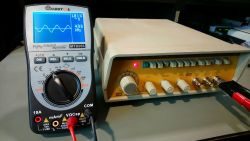
8kHz:
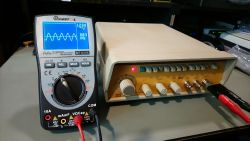
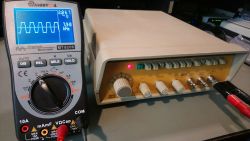

10kHz:

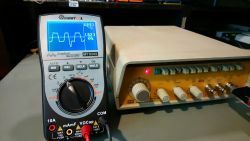
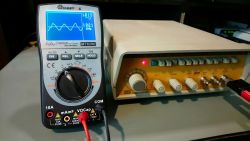
The multimeter itself, as I mentioned, is slow, but it turned out to be accurate:
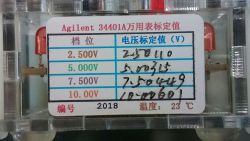
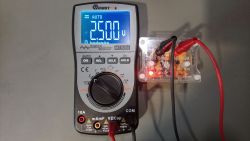
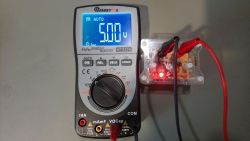

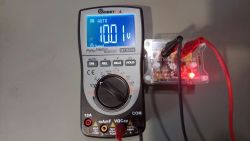
Uref [V]: Umea [V]
2.50110: 2.500
5.00315: 5.00
7.50449: 7.51
10.00601: 10.01
A positive surprise was the measuring range of the multimeter:
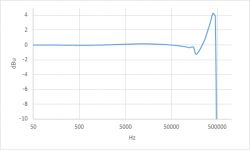
Up to 150 kHz the characteristic is practically flat, and up to 250 kHz the indications can be considered correct. The continuity tester has a "latch" and is very fast. The current consumption from the battery is about 46mA (in voltmeter mode).
As a summary, I will write this - as a multimeter it is correct, as an oscilloscope - tragic, better can be done on an Arduino. For a price of up to PLN 200 you can buy a much better multimeter, or a similar class multimeter and toy oscilloscopes like the DSO138, which will "beat the head" with the utility of the one integrated with MT8206.
Taking advantage of the promotion, I bought such a meter on the Banggood.com portal for less than 38 EUR (160 PLN). I will briefly try to describe here why (not) it is worth buying it.
The parcel arrived very quickly (13 days), it was sent by Dutch post from ... the Netherlands. There is no trace that it is a shipment from China, there is no customs declaration, there is only one address sticker and nothing under it ... and what's inside. Well, inside was a cardboard box (colored) with a meter. The meter is quite large, but it does not differ from the average: 160x80x30, it does not have a holster, it is twisted with 4 thin screws. It is quite heavy, weighing 260g with batteries. The structure is quite stiff and makes a positive impression. It is powered by 3 AA (R6) batteries. The set includes a cover and decent quality test leads (very flexible, but not silicone) and a user manual (in English):

The screen is a graphic, monochrome negative LCD, with LED (cool white) backlighting. The font unnecessarily mimics a 7-segment display. The range selector knob is quite small and it moves quite heavy, and at the same time "dull". Occasionally, the meter reboots or turns off completely while switching ranges. The function buttons sometimes lock in the pressed position. While in the lying position the meter can be operated with one hand, in the standing position - it is out of the question. The service itself is quite intuitive to eat, and the first thing that catches the eye is - "he's so slow". The multimeter has a bargraph, but I have the impression that its refresh rate is ... lower than that of the digital display. The meter belongs to the 4000 counts category, which is not the best. It has a relative measurement mode (REF) and the possibility of manual selection of the measuring range. Have I already written that it is terribly slow? He sometimes "misses" the result, but not always. Sometimes the indication slowly increases, sometimes "oL" appears "along the way" (when switching the range), and sometimes "overshoot", eg measurement 12V - subsequent indications: 3.00, 14.06, 12.01. As for the oscilloscope function - it was no surprise here - there is ... and so much good you can write about it (which was to be expected from the description). The oscilloscope works in the equivalent time sampling mode, you need to wait about 2 seconds for the graph to refresh, there are no divisions, only the time base is adjustable. It realistically allows for the imaging of the waveform to a frequency of about 8kHz, but above 5kHz it is difficult to distinguish a triangular wave from a sinusoidal one. Oscilloscope mode is available in the voltmeter and ammeter ranges for both AC and DC ranges. For DC ranges it acts as an oscillograph (slow-variable waveform recorder), but it reacts as slowly as the multimeter itself and does not have a roll mode.
Inside, it is a typical Chinese design, interestingly, it has no replaceable fuses, only soldered, miniature SMD fuses:


This is how the waveforms from the generator appear on the "oscilloscope" screen:
1kHz:



5kHz:



8kHz:



10kHz:



The multimeter itself, as I mentioned, is slow, but it turned out to be accurate:





Uref [V]: Umea [V]
2.50110: 2.500
5.00315: 5.00
7.50449: 7.51
10.00601: 10.01
A positive surprise was the measuring range of the multimeter:

Up to 150 kHz the characteristic is practically flat, and up to 250 kHz the indications can be considered correct. The continuity tester has a "latch" and is very fast. The current consumption from the battery is about 46mA (in voltmeter mode).
As a summary, I will write this - as a multimeter it is correct, as an oscilloscope - tragic, better can be done on an Arduino. For a price of up to PLN 200 you can buy a much better multimeter, or a similar class multimeter and toy oscilloscopes like the DSO138, which will "beat the head" with the utility of the one integrated with MT8206.
Cool? Ranking DIY







